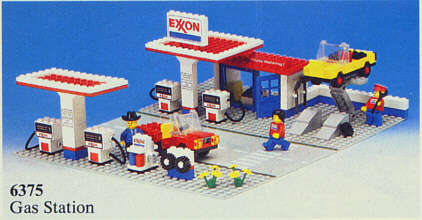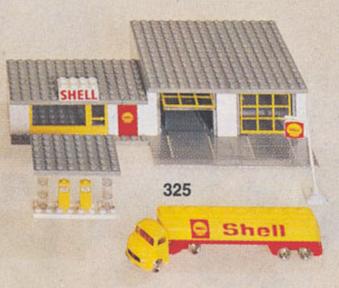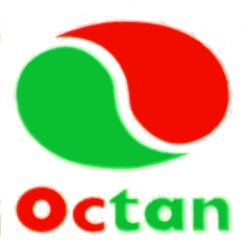I got an email the other day about a petition started by Greenpeace urging LEGO, the world-famous toy company that was a mainstay of my childhood (continuing on into my adulthood), to cut its ties with Shell, the world-infamous oil company that has faced major opposition for its plans to drill in the Arctic. I am a huge fan of LEGO, and not at all a huge fan of Shell, but I decided to look into this campaign a bit more, in part because the LEGO/Shell partnership didn’t seem like a new deal to me. In fact, I was pretty sure I had a LEGO Shell gas station as a kid.
I was close. It was a LEGO Exxon gas station.

Via Brickipedia
According to Brickipedia, LEGO had a licensing deal with Exxon for sets sold in the U.S., beginning as early as 1979, when it released a fuel tanker set. It released the gas station set in 1980, along with a tow truck that had Exxon logos on the doors. It also released another fuel tanker set—with room for the minifigure to sit behind the wheel—in 1984. I’m pretty sure I had all of these sets. LEGO used the Esso brand until the Exxon brand largely replaced it in the U.S. in the 1970’s.
As for Shell, I remembered seeing Shell sets in LEGO catalogs. LEGO began making Shell-branded products, such as the “Shell Service Station,” in 1966:

Via Brickipedia
The company began selling Shell-branded sets in the U.S. in 1986. Aside from a few promotional items offered in the 1990’s, LEGO stopped using the Shell or Exxon logos on its sets in 1992, when it introduced the fictional brand Octan.

Via Brickipedia
I haven’t seen The LEGO Movie yet, but apparently Octan is featured prominently.
Okay, so what’s my point? I guess my first point is that a corporate partnership between LEGO and Shell is nothing new, but that doesn’t mean that people shouldn’t oppose the current deal. Drilling in the Arctic is potentially a huge problem. I’ll get to Shell in a second, but first, what does LEGO have to say about this? A statement from the CEO of LEGO has the expected amount of corporate jargon about how the company’s responsibility is “to bring LEGO® bricks into the hands of more children.”
Slapping oil company logos all over toys doesn’t seem to me like the best way to get more kids playing with LEGOs, but then again, I was never a McKinsey consultant like LEGO Group CEO Jørgen Vig Knudstorp. Honestly, my beef with LEGO began when it stopped making kids assemble horses out of individual bricks in favor of molded plastic horses.

These are horses, if you use a tiny bit of your imagination (via Brickipedia).
From there, everything got even less imaginative.
Shell doesn’t exactly have the best track record around the world on environmental or human rights issues, especially in places like Nigeria.
As for its plans to drill in the Arctic—specifically in waters off the coast of Alaska—is there any reason to think the company would do any better? There are far fewer people in that area than in, say, the Niger Delta, but that doesn’t mean accidents wouldn’t be completely devastating. The company has postponed its drilling plans for the rest of 2014, and that ought to give them time to come up with far better safety measures than their competitors (not necessarily a high bar, I realize).
I don’t know how much of an impact a boycott of LEGO, or a different type of pressure campaign, would have on Shell’s plans for the Arctic, but it would probably be a greater impact than doing nothing. I don’t actually purchase LEGO products much, so it’s hard for me to say how I could boycott them. To me, LEGO is a medium for art and creativity—not that I build anything with them myself, because the ship of my youthful creativity seems to have sailed, alas. I just support those who do some pretty amazing things with them.
One other thought occurred to me with regards to a partnership between an oil company and a company that makes plastic toy pieces: What are LEGO bricks actually made of? It’s a durable plastic material that hurts like hell to step on, and while I don’t know much of anything about chemistry or chemical engineering, I know that plastics and oil are closely related to one another.
According to LEGO, it manufactures LEGO bricks and other pieces (which it calls “elements”) at wholly-owned factories in Denmark, Hungary, the Czech Republic, and Mexico. The plastic must be heated to between 446 and 590° F, then molded at pressures of 25 to 150 tons. These factories produced over 36 billion elements in 2011, a rate of 1,140 per second. That’s interesting, but it doesn’t quite answer my question.
According to the Discovery Channel, the process begins with heating acrylonitrile butadiene styrene (ABS) granules. These are melted, molded, etc. That’s more specific, but now I have to get into complex chemical names, don’t I? Ugh. Here’s what Wikipedia says: “ABS is a terpolymer made by polymerizing styrene and acrylonitrile in the presence of polybutadiene.” The proportions are generally:- Acrylonitrile: 15-35%
- Butadiene: 5-30%
- Styrene: 40-60%
I’ll let somebody else worry about whether those numbers add up to 100. Here’s where we get to the part about what LEGOs are made of.
Styrene is a derivative of benzene (which can be seriously nasty stuff, but that doesn’t mean that LEGO bricks are dangerous). It occurs naturally in the resin of certain trees, and it can be synthesized through the dehydrogenation of ethylbenzene. Ethylbenzene is a naturally-occurring petrochemical found in petroleum and coal tar.
Acrylonitrile is both toxic and highly flammable. When burning, it can produce hydrogen cyanide and nitrogen dioxide. It is typically produced by catalytic ammoxidation of propylene, which occurs in nature as a fermentation byproduct and is also derived from natural gas an petroleum.
Polybutadiene is a synthetic rubber created through the polymerization of 1,3-butadiene, which can be derived from various forms of natural gas and petroleum.
My point is merely this: LEGO elements are composed of a plastic made of three central ingredients (chemists and chemical engineers, if you’re still reading, I’m so, so sorry for mangling your lingo). Those three ingredients, in turn, are produced from three chemicals, ethylbenzene, propylene, and 1,3-butadiene, that are commonly derived from oil or natural gas.
With that in mind, it makes perfect sense for LEGO to partner with an oil company like Shell, because LEGO bricks are, in a way, made of oil.
Photo credits: Brickipedia; ABS_grains.jpg: Ollixtc, Righello.jpg: Luigi Chiesa, derivative work: SaraCSF (ABS_grains.jpg, Righello.jpg) [CC-BY-SA-3.0], via Wikimedia Commons.


![By ABS_grains.jpg: Ollixtc Righello.jpg: Luigi Chiesa derivative work: SaraCSF (ABS_grains.jpg Righello.jpg) [CC-BY-SA-3.0 (http://creativecommons.org/licenses/by-sa/3.0)], via Wikimedia Commons By ABS_grains.jpg: Ollixtc Righello.jpg: Luigi Chiesa derivative work: SaraCSF (ABS_grains.jpg Righello.jpg) [CC-BY-SA-3.0 (http://creativecommons.org/licenses/by-sa/3.0)], via Wikimedia Commons](http://crypticphilosopher.com/wp-content/uploads/2014/08/Grãos_de_plástico_ABS_ABS_plastic_grains.jpg)
